#ngc 6822
Explore tagged Tumblr posts
Text

Barnard's Galaxy, NGC 6822 // Neil Corke
#astronomy#astrophotography#galaxy#irregular galaxy#star-forming galaxy#Barnard's Galaxy#NGC 6822#IC 4895#sagittarius
54 notes
·
View notes
Text
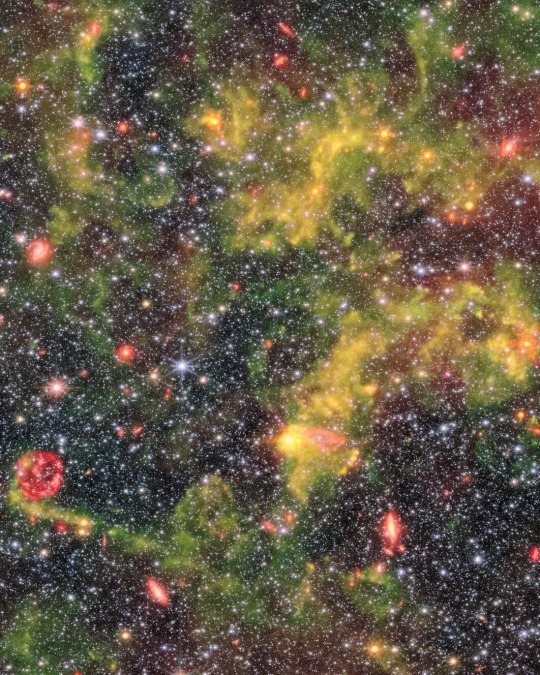
Gas-rich NGC 6822: Barnard's Galaxy © JWST
#galaxy#space#ngc 6822#astrophotography#stars#night sky#universe#solar system#nasa#jwst#webb#james webb space telescope#astronomy#planet#cosmos
612 notes
·
View notes
Text



The life and times of dust, Galaxy NCG 6822
l ESA/Webb l MiRi l NiR+MiRi l NiR
#nasa#esa#webb#space#astrophotography#astronomy#ngc 6822#james webb telescope#stars#universe#solar system#planets#galaxy#sky
963 notes
·
View notes
Text

Supernova Ring and Ghost Galaxy
397 notes
·
View notes
Text



ngc 6822
#jwst#james webb space telescope#ngc 6822#how tho#the universe is just crazy yo#irregular galaxy#barnards galaxy#sagittarius constellation#nircam#ic 4895
11 notes
·
View notes
Text

Galaxy NGC 6822 by Webb Telescope
The life and times of dust
This image shows the irregular galaxy NGC 6822, which was observed by the Near-InfraRed Camera (NIRCam) and Mid-InfraRed Instrument (MIRI) mounted on the NASA/ESA/CSA James Webb Space Telescope.
NGC 6822 lies about 1.5 million light-years away, and is the Milky Way’s nearest galactic neighbour that is not one of its satellites. It has a low metallicity, meaning that it contains low proportions of elements that are not hydrogen and helium. Metallicity is an absolutely key concept in astronomy, in part because elements other than hydrogen and helium are largely produced by stars over their lifetimes. Therefore, in the very early Universe (before the first generation of stars had been born, lived and died) everything had very low metallicity. This makes contemporary low-metallicity objects (like NGC 6822) objects of interest for understanding how processes such as the evolution of stars and the life cycle of interstellar dust likely occurred in the early Universe. This was the motivation for these observations of NGC 6822 with Webb: to better understand how stars form and how dust evolves in low-metallicity environments.
ESA/Webb, NASA & CSA, M. Meixner.

#Galaxy NGC 6822 by Webb Telescope#james webb telescope#james webb photos#james webb images#galaxy#galaxies#space#nasa#nasa picture of the day
44 notes
·
View notes
Text

This is an image of the nearest galaxy to our Milky Way that’s not one of its satellites—NGC 6822, sitting 1.6 million light-years away. It has an interesting history.
In 1884, the galaxy was presented by astronomer Edward Emerson Barnard as an “exceedingly faint nebula.” In 1925, Edwin Hubble—the namesake of the Hubble Space Telescope—studied this object and noted its importance for understanding of the universe.
Hubble was correct. NGC 6822 is a galaxy with low metallicity, meaning it contains low proportions of elements other than hydrogen or helium. These conditions provide astronomers the means to study an environment similar to that of the early universe, in which most galaxies contained only hydrogen or helium.
This image was captured by the James Webb Space Telescope.
Credit: ESA/Webb, NASA & CSA, M. Meixner.
119 notes
·
View notes
Text
First light from ESA's new Euclid space telescope with an ultra high-res, wide-angle lens to map the structures of the universe, helping astronomers study dark matter/energy.
Perseus Cluster of Galaxies

This Moon-sized patch of sky looks back ten billion light-years and shows about 100,000 galaxies, plus some stars from our own galaxy (points with diffraction spikes).
The cluster's Y shape reveals the gravitational influence of dark matter filaments, the web of the universe which until now was too big to fit in any telescope's view.
The Hidden Galaxy (IC 342)
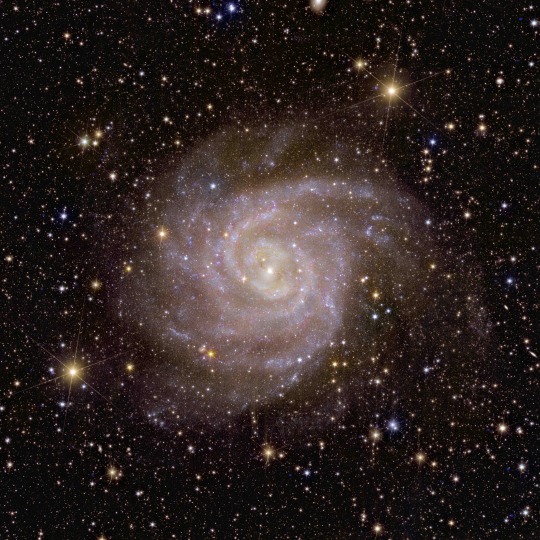
Euclid took only 5 hours to peer through the thickest part of our own galaxy edge-on and capture this galaxy hidden behind it.
Its spiral shape gives us an idea what the Milky Way would look like from above. The image is false color: red has been shifted towards blue so infrared can be shifted up to red we can see.
Irregular Dwarf Galaxy NGC 6822
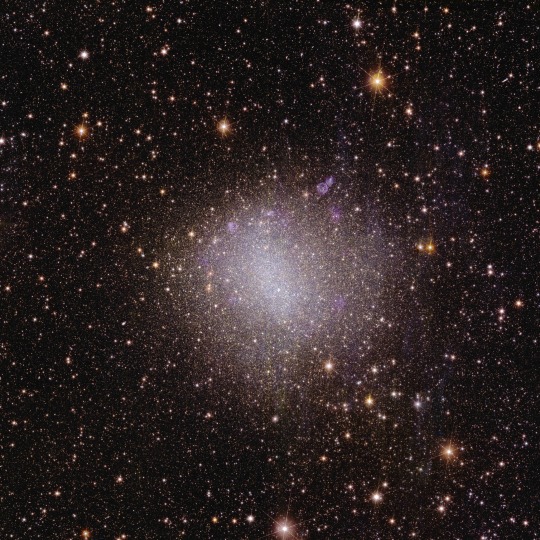
Just 1.6 million light-years from Earth, this little companion to the Milky Way is so close that until now it could only be captured in low res by ground telescopes or zoomed in to just one small part by Webb or Hubble.
It has a lot of old, low-metal, first-generation stars that can help astronomers study the universe's history.
Globular Star Cluster NGC 6397

It looks similar to a dwarf galaxy, but is much smaller and closer at just 7800 light-years away, and it's within the Milky Way. Perturbations of its outer stars in streaks and waves give clues about gravitational interactions within the Milky Way.
Again, other telescopes can't see the whole cluster in any detail, both because of its size and the high contrast between the bright center and faint outer stars, which would take Hubble hours to capture. Euclid imaged both in just an hour.
The Horsehead Nebula

This smear of dust lies in the larger star-forming region of the Orion Nebula just below Orion's belt. It's one of the most busy star nurseries in our vicinity, just 1375 light-years away.
Euclid's resolution is such that close study of this one-hour exposure should reveal many baby stars, brown dwarfs, and young Jupiter-mass planets.
236 notes
·
View notes
Text
NGC 6822 New image from James Webb Space Telescope

#james webb images#james webb photos#jwst images#jwst#astronomy#nasa#astronomers#universe#nasa photos#astrophotography#astrophysics#outer space#nasawebb#hubble space telescope#space travel#international space station#space science#space exploration#space#space shuttle#our universe#cosmos#planetary nebula#nebula#planetary science#nasa science#science facts#science#i love astronomy#astronomy facts
68 notes
·
View notes
Text
The Year’s Most Spectacular Photos from the James Webb Telescope
By Jeffrey Kluger
December 22, 2023

Close to 1,500 light years from Earth lie a pair of baby stellar twins known as Herbig-Haro 46/47 — which are barely a few thousand years old.
A star the size of our sun, by contrast, takes an average of 50 million years to reach even the stellar equivalent of young adulthood It's Herbig-Haro 46/47's extreme youth that gives the formation more of a blob-like appearance than the stellar duo it is.
Young stars are buried in clouds of dust and gas, which they absorb as they grow. Sometimes, however the infant stars ingest too much material too fast.
When that happens, dust and gas erupts from both sides of the formation, giving the young pair their misshapen look.
But if you have patience — 50 million years worth of patience — what is a blob today will be stars tomorrow.
NASA, ESA, CSA. Image Processing: Joseph DePasquale (STScI)
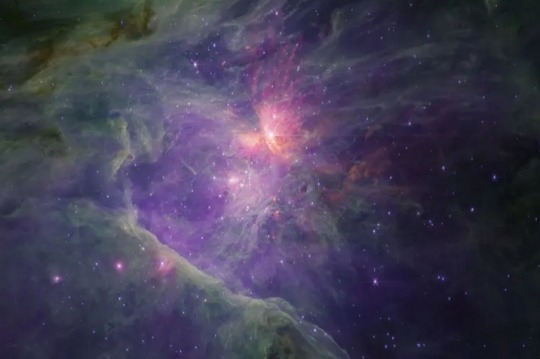
A pair of brilliant stellar nurseries located 1,600 light years from Earth, the Orion Nebula and Trapezium Cluster are home to a relative handful of very young but very bright stars.
Four of the stars are easy to see with a simple, amateur, four-inch telescope.
One of the four — the beast of the young litter — is especially visible, a full 20,000 times brighter than our sun.
Apart from their four main stars, the Orion Nebula and Trapezium cluster contain approximately 700 additional young stars at various stages of gestation.
NASA, ESA, CSA/Science leads and image processing: M. McCaughrean, S. Pearson, CC BY-SA 3.0 IGO

(L): It’s not easy being a Wolf-Rayet star, like this specimen imaged by the Webb telescope at a distance of 15,000 light years.
A rare species of stellar beast — NASA estimates there are only 220 of them in a Milky Way galaxy with at least 100 billion stars — the Wolf-Rayet burns hot and burns fast, with temperatures 20 to 40 times the surface of the sun.
All of that rapidly expended energy causes the star to lose its hydrogen envelope quickly and expose its helium core.
The result: a very early and very violent death.
A star like our sun burns for about 10 billion years. As for a Wolf-Rayet? Just a few hundred thousand before it dissolves into cosmic dust.
NASA, ESA, CSA, STScI, Webb ERO Production Team
(R): If the Wolf-Rayet star dies an ugly and violent death, the celebrated Ring Nebula, photographed by the Webb at a distance of 2,000 light years from Earth, has been expiring beautifully.
The glowing remains of a sun-like star, the nebula was discovered in 1779 by the French astronomer Antoine Darquier de Pellepoix.
As the nebula throws off its outer layers of ionized gas, it reveals its characteristic blue interior, composed of hydrogen and oxygen that have not yet been expelled off by the nebula’s stellar wind.
ESA/Webb, NASA, CSA, M. Barlow (University College London), N. Cox (ACRI-ST), R. Wesson (Cardiff University)
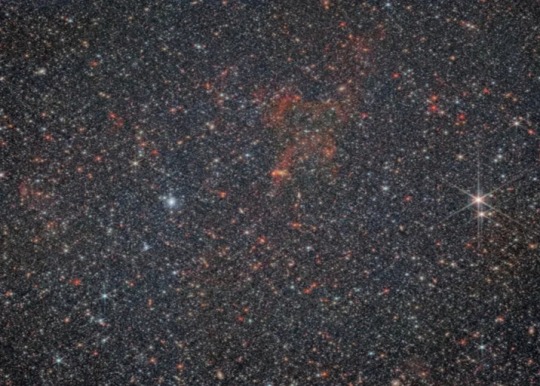
Dwarf galaxy NGC 6822 lives up to to its name — home to just 10 million stars, compared to the minimum of 100 billion in the Milky Way.
But what NGC 6822 lacks in numbers, it makes up in spectacle — which the keen eye of the Webb telescope has revealed.
Discovered in 1884 by American astronomer E.E Barnard, NGC 6822, is now known to have a prodigious dust tail measuring 200 light years across..
What's more, it's home to a dense flock of stars that glow 100,000 times brighter than our sun.
ESA/Webb, NASA & CSA, M. Meixnev

Spiral galaxies are often defined by uneven — and even ragged — arms.
But not galaxy M51, which lies 27 million light years from Earth and is defined by the tautness of its arms and the compactness of its structure.
M51 isn't alone in space. Nearby lies the companion galaxy NGC 5195.
The two galaxies are engaged in something of a gravitational tug of war — one that the NGC 5195 is winning.
NGC's constant gravitational pull is thought to account for both the tightly woven structure of M51's arms and for tidal forces that are thought lead to the creation of new stars in the arms.
ESA/Webb, NASA & CSA, A. Adamo (Stockholm University) and the FEAST JWST team
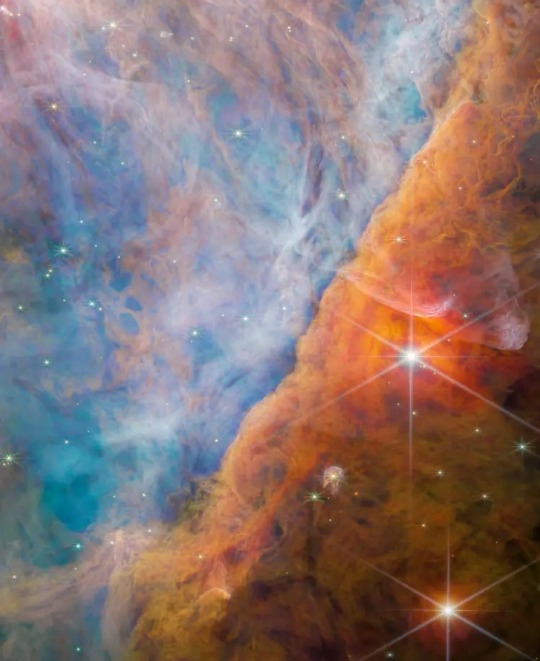
Just below Orion’s belt lies one of the most celebrated objects in the night sky: the Orion Nebula, a stellar nursery that is home to about 700 young stars.
This Webb image focuses not on the entirety of the nebula but on a structure in the lower left-hand quadrant known as the Orion Bar.
So named because of its diagonal, ridge-like appearance, the bar is shaped by the powerful radiation of the hot, young stars surrounding it.
ESA/Webb, NASA, CSA, M. Zamani (ESA/Webb), and the PDRs4All ERS Team

A baby by stellar standards, the IC 348 Star cluster is just five million years old and located about 1,000 light years from Earth.
Composed of an estimated 700 stars, IC 348 has a structure similar to wispy curtains, created by dust that reflects the light of the stars.
The conspicuous loop in the right hand side of the image is likely created by the gusting of solar winds blowing in the direction that, from Earth, would be west to east.
NASA, ESA, CSA, STScI, Kevin Luhman (PSU), Catarina Alves de Oliveira (ESA)
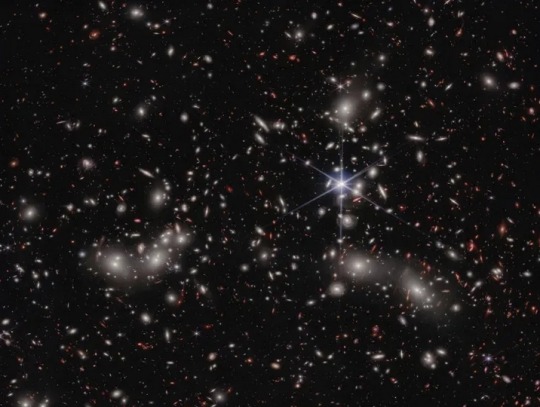
When it comes to galaxies, there's big and then there's huge and by any measure, Pandora's Cluster — more formally, known as Abell 2744 — qualifies as the latter.
Not just a galaxy, and not even a cluster of galaxies, Abell 2744 is a cluster of four clusters, which long ago collided with one another.
Located 3.5 billion light years from Earth, Pandora's Cluster measures a staggering 350 million years across.
The cluster's massive collective gravity allows astronomers to use it as a gravitational lens, bending and magnifying the light of foreground objects, making them easier to study.
NASA, ESA, CSA, I. Labbe (Swinburne University of Technology) and R. Bezanson (University of Pittsburgh). Image processing: Alyssa Pagan (STScI)

Webb was built principally to look at the oldest and most distant objects in the universe, some of 13.4 billion light years away.
But doesn't prevent the telescope from peering into its own back yard.
This image of Saturn and some of its 146 moons, rivals the images obtained by the Pioneer and Voyager probes.
NASA, ESA, CSA, STScI, Matt Tiscareno (SETI Institute), Matt Hedman (University of Idaho), Maryame El Moutamid (Cornell University), Mark Showalter (SETI Institute), Leigh Fletcher (University of Leicester), Heidi Hammel (AURA). Image processing: J. DePasquale (STScI)
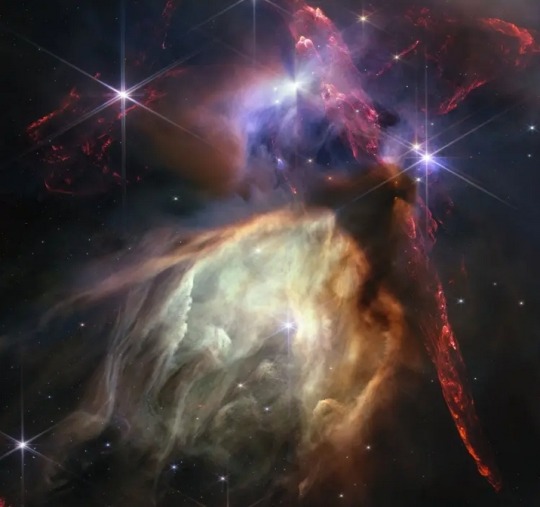
Infant stars are born all over the universe, but the closest stellar birthing suite to Earth is the Rho Ophiuchi cloud complex, located just 460 light years distant.
A turbulent — even violent — place, Rho Ophiuchi is defined by jets of gas roaring from young stars.
Most of the stars in this comparatively modest nursery are more or less the size of the sun.
But one, known as S1, is far bigger — so much so that it is self-immolating, carving a great cavity around itself with its stellar wind, the storm of charged particle's all stars emit, though few with the gale-force power of S1.
NASA, ESA, CSA, STScI, Klaus Pontoppidan (STScI)
#James Webb Telescope#James Webb Space Telescope#telescope#space#stars#galaxies#universe#cosmos#astronomy#space photography#photpgraphy#NASA#galactic clusters#milky way galaxy#Orion’s belt#Orion Nebula#Orion Bar#Pandora's Cluster#Saturn#Rho Ophiuchi cloud complex#Trapezium Cluster#Wolf-Rayet#Ring Nebula#Antoine Darquier de Pellepoix#E.E Barnard#spiral galaxy#nebula
113 notes
·
View notes
Photo

NGC 6822: Barnard s Galaxy
Credits: Dietmar Hager, Eric Benson
25 notes
·
View notes
Text
Unveiling the Mysteries of NGC 6822 with James Webb Space Telescope. Read full article here

📸 Check out this mesmerizing image captured by the Near-InfraRed Camera (NIRCam) and Mid-InfraRed Instrument (MIRI) on the James Webb Space Telescope! The swirling yellow patterns indicate gas-rich regions, while the densely packed field of stars in this galaxy looks absolutely mind-blowing! 😍
💫 Fun fact alert: NGC 6822 has a fascinating history that dates way back! E. E. Barnard discovered it in 1884 and mistook it for a faint nebula 🤔. But Edwin Hubble (yes, the Hubble Space Telescope guy!) did some major deep diving in 1925, confirming that this beauty was way beyond our Milky Way! Mind = blown! 🤯
Read full article here-
#SpaceDiscovery#NGC6822#JamesWebbTelescope#CosmicJourney#AstronomyGeek#StarryEyed#SpaceNerd#CosmicMysteries#SpaceExploration
16 notes
·
View notes
Text

Infrared Irregularity
155 notes
·
View notes
Text
This scaled image shows the irregular galaxy NGC 6822, which was observed by the Near-InfraRed Camera (NIRCam) mounted on the NASA/ESA/CSA James Webb Space Telescope.
Webb’s near-infrared NIRCam image shows the galaxy’s countless stars in incredible detail. Here, the dust and gas that pervade the galaxy are reduced to translucent red wisps, laying the stars bare for astronomical study. The power of Webb’s ice-cold infrared instruments and the incredible resolution of its primary mirror is necessary to examine stars hidden in dusty environments, and the results as shown here are spectacular.
The brightest stars appear in pale blue and cyan colours in this image, colours which are assigned to the shortest wavelengths of light that NIRCam can detect: red and near infrared. The amount of light emitted by any star decreases at longer and longer wavelengths, towards the mid-infrared, so the stars that are more faint to NIRCam also appear more warmly coloured here. A bright blue orb to the lower left of the gas is particularly prominent: this is a globular cluster, packed with stars.
This image has been cropped and downscaled from the full NIRCam resolution to match that of the MIRI image. See a combined MIRI+NIRCam view, and more information about NGC 6822, here.
0 notes
Video
youtube
【暗黒宇宙】ユークリッド、驚くべき初の5つのフルカラー科学画像を公開!ダークマターとダークエネルギーを探る(4K)
暗黒宇宙の謎を解明する新衛星Euclid(ユークリッド)による、 画期的な最近の成果に迫ります!
オリオン座の馬頭星雲のクローズアップをはじめ、 ・ペルセウス座銀河団 ・渦巻銀河 IC 342 ・不規則銀河 NGC 6822 ・球状星団 NGC 639
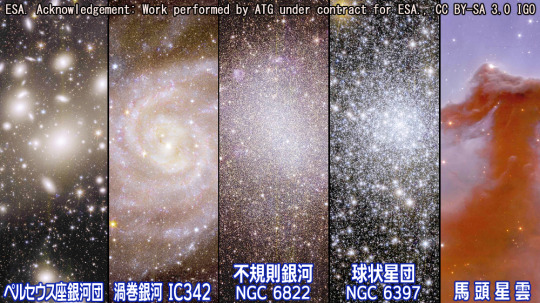
など、ユークリッドがとらえた魅力的な画像をご覧ください! 本番である全天調査は、この写真の3万倍の大きさを撮る予定です。
暗黒の宇宙に興味がありますか? この動画では、宇宙の95%を占める暗黒物質と暗黒エネルギーの 秘密を解き明かすヒントをこの5つの科学画像から迫ります。 またユークリッド宇宙望遠鏡のミッションや 次期、ローマン宇宙望遠鏡についても触れ、ゆっくりと解説します。
もはや時代は、立体構造の3D観測映像時代の幕開け! ユークリッドは次に宇宙の何を明らかにするのか? どうぞお楽しみに!
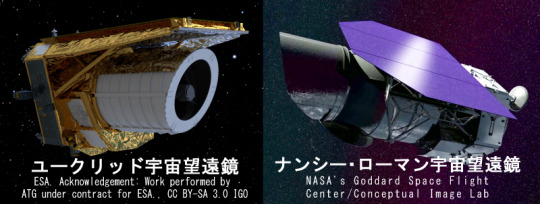
ユークリッドとともに宇宙の真のファーストライトを 探る宇宙の旅をお見逃しなく。
🌌見逃し配信はこちらから🌌 欧州宇宙機関「ESA」6年間で挑む暗黒宇宙の謎5選! https://youtu.be/M4N_PQCaJ9o
3D宇宙の鍵となる最初のテスト画像が公開 https://youtu.be/K6A-a5QcKbE
📝目次📝 --------------- 0:00 最初の5つの科学画像 0:39 Euclidミッションとは 1:40 鮮明高解像度の成果 2:30 ペルセウス座銀河団 4:03 宇宙の網・フィラメント構造とは 6:30 渦巻銀河IC342 8:45 不規則銀河NGC6822 11:24 球状星団NGC6397 14:57 馬頭星雲 18:20 総まとめ 19:58 ローマン宇宙望遠鏡
どうぞ、最後までお楽しみください!
⭐️チャンネル登録はこちらから⭐️ https://www.youtube.com/@soranohoshi

このチャンネルでは、宇宙や星空の情報や知識を親しみやすく、 ゲームやアニメ感覚でシェアしていくチャンネルです。 今後の動向や、宇宙や星々に興味がわきましたら、 是非!チャンネル登録もしていただけると嬉しいです。
アンケートや感想、いいねボタンも大変励みになります。 お気軽にご参加ください。
日々の星空ライフを充実したものに。 今後、人類のさらなる宇宙への挑戦を見守っていきましょう。
🎬気になるグッズ・映画🎬 以下、一部リンクにはアフェリエイト【PR】が含まれます。 ------------------------------------------------- ▼ダークマターと恐竜絶滅 新理論で宇宙の謎に迫る [電子書籍版] 【PR】https://a.r10.to/hkFiXq
▼宇宙のダークエネルギー 「未知なる力」の謎を解く (光文社新書) 【PR】https://amzn.to/3stSjJS
▼ダークマター スパイスド ラム 40度 700ml (スコットランド産ラム) 【PR】https://a.r10.to/h44ZH6
📘資料・出典📘 ------------------------------------------------- フリー百科事典『ウィキペディア(Wikipedia)』 天文学辞典:天体に関する用語を3,000語以上収録・解説。 https://astro-dic.jp/ ・ユークリッド (宇宙望遠鏡) ・ダークエネルギー ・ダークマター ・暗黒エネルギー ・暗黒物質
【公式】欧州宇宙機関「ESA」 https://www.esa.int/
【公式】ESA - ユークリッド専用サイト https://www.esa.int/Science_Exploration/Space_Science/Euclid
【公式】Euclidコンソーシアム https://www.euclid-ec.org/
📀使用ソフト📀 ------------------------------------------------- ▼Space Engine –宇宙シミュレーターソフト http://spaceengine.org/ ロシアの天文学者でプログラマによる独自の3D宇宙空間 シミュレーションソフトウェアおよびゲームエンジン。 ※当動画は、Proライセンスを取得して���信しています。
▼ステラナビゲータ12/AstroArts 最新版・純国産の天文シミュレーションソフトウェア。 【PR】https://a.r10.to/hU8Ip9
▼Universe Sandbox 2 宇宙物理シミュレーションソフト http://universesandbox.com/
▼CeVIO AI さとうささら すずき つづみ 弦巻マキ(日本語&英語) 深層学習等のAI技術を使い、声質・癖・喋り方をリアルに再現した 新世代の音声創作ソフトウェア最新版!
【Amazon PR】さとうささら(トークスターター|ダウンロード版) https://amzn.to/3srohGr
【楽天 PR】弦巻マキ トークスターターパック (日本語&英語) Windows用 https://a.r10.to/hNL2BI
【Amazon PR】すずきつづみ(トークスターター|ダウンロード版) https://amzn.to/3sjDGZz
この動画はCeVIOプロジェクトの「さとうささら」「弦巻マキ」「すずきつづみ」を使用しています。
🎬おすすめ動画リスト🎬 ------------------------------------------------- ▼【ユークリッド衛星(Euclid)】ダークマター(暗黒物質)、ダークエネルギー(暗黒エネルギー)、 暗黒宇宙最大の謎に迫る!人類挑戦の記録 https://youtube.com/playlist?list=PLVD9xZXaEKsVzd5_KmK_Ve7TBwPQIXFIM
🔽ブログやSNS🔽 ------------------------------------------------- ⭐️宙の星ブログ⭐️ https://soranohoshi.com/

0 notes